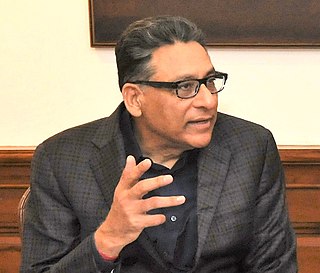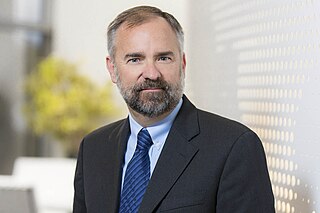
Advanced Micro Devices, Inc. (AMD) is an American multinational corporation and semiconductor company based in Santa Clara, California, that develops computer processors and related technologies for business and consumer markets.

Intel Corporation is an American multinational corporation and technology company headquartered in Santa Clara, California, and incorporated in Delaware. Intel is one of the world's largest semiconductor chip manufacturers by revenue and ranked in the Fortune 500 list of the largest United States corporations by revenue for nearly a decade, from 2007 to 2016 fiscal years, until it was removed from the ranking in 2018. In 2020, it was reinstated and ranked 45th, being the 7th-largest technology company in the ranking.

An integrated circuit, also known as a microchip, chip or IC, is a small electronic device made up of multiple interconnected electronic components such as transistors, resistors, and capacitors. These components are etched onto a small piece of semiconductor material, usually silicon. Integrated circuits are used in a wide range of electronic devices, including computers, smartphones, and televisions, to perform various functions such as processing and storing information. They have greatly impacted the field of electronics by enabling device miniaturization and enhanced functionality.

A microprocessor is a computer processor for which the data processing logic and control is included on a single integrated circuit (IC), or a small number of ICs. The microprocessor contains the arithmetic, logic, and control circuitry required to perform the functions of a computer's central processing unit (CPU). The IC is capable of interpreting and executing program instructions and performing arithmetic operations. The microprocessor is a multipurpose, clock-driven, register-based, digital integrated circuit that accepts binary data as input, processes it according to instructions stored in its memory, and provides results as output. Microprocessors contain both combinational logic and sequential digital logic, and operate on numbers and symbols represented in the binary number system.

In a computer system, a chipset is a set of electronic components on one or more integrated circuits that manages the data flow between the processor, memory and peripherals. The chipset is usually found on the motherboard of computers. Chipsets are usually designed to work with a specific family of microprocessors. Because it controls communications between the processor and external devices, the chipset plays a crucial role in determining system performance.

Vinod Dham is an Indian-American engineer, entrepreneur, and venture capitalist. He is known as the 'Father of the Pentium Chip' for his contribution to the development of Intel's Pentium micro-processor. He is also a mentor and advisor, and sits on the boards of companies, including startups funded through his India-based fund Indo-US Venture Partners, where he is the founding managing director.

A multi-chip module (MCM) is generically an electronic assembly where multiple integrated circuits, semiconductor dies and/or other discrete components are integrated, usually onto a unifying substrate, so that in use it can be treated as if it were a larger IC. Other terms for MCM packaging include "heterogeneous integration" or "hybrid integrated circuit". The advantage of using MCM packaging is it allows a manufacturer to use multiple components for modularity and/or to improve yields over a conventional monolithic IC approach.
The transistor count is the number of transistors in an electronic device. It is the most common measure of integrated circuit complexity. The rate at which MOS transistor counts have increased generally follows Moore's law, which observes that transistor count doubles approximately every two years. However, being directly proportional to the area of a chip, transistor count does not represent how advanced the corresponding manufacturing technology is: a better indication of this is transistor density.

Padmasree Warrior is an Indian-American businesswoman and technology executive. She is known for her leadership roles in technology firms like Cisco where she served as the CTO for seven years, and at Motorola where she was the CTO for five years. She also served as the CEO of Nio USA, an electric car maker. Currently, she is the founder and CEO of Fable, a curated reading platform focused on mental wellness. She also serves on the board of directors of Microsoft and Spotify.

In 2008, Mark Papermaster, IBM's Vice President of the Blade Development Unit, became the subject of a notable trade secret misappropriation and non-compete clause case when he announced a plan to move to Apple as Senior Vice President of Devices Hardware Engineering. On October 22, 2008, IBM filed a complaint against Papermaster claiming breach of contract and misappropriation of trade secrets. They sought a preliminary injunction to prevent Papermaster from working at Apple, claiming his employment violated non-competition agreement.
In semiconductor manufacturing, the International Roadmap for Devices and Systems defines the "5 nm" process as the MOSFET technology node following the "7 nm" node. In 2020, Samsung and TSMC entered volume production of "5 nm" chips, manufactured for companies including Apple, Marvell, Huawei and Qualcomm.
In semiconductor manufacturing, the "7 nm" process is a marketing term for the MOSFET technology node following the "10 nm" node, defined by the International Technology Roadmap for Semiconductors. It is based on FinFET technology, a type of multi-gate MOSFET technology.

Lisa Tzwu-Fang Su is an American business executive and electrical engineer who is the president, chief executive officer and chair of AMD. Early in her career, Su worked at Texas Instruments, IBM, and Freescale Semiconductor in engineering and management positions. She is known for her work developing silicon-on-insulator semiconductor manufacturing technologies and more efficient semiconductor chips during her time as vice president of IBM's Semiconductor Research and Development Center.
James B. Keller is an American microprocessor engineer best known for his work at AMD, Apple, and Tesla. He was the lead architect of the AMD K8 microarchitecture and was involved in designing the Athlon (K7) and Apple A4/A5 processors. He was also the coauthor of the specifications for the x86-64 instruction set and HyperTransport interconnect. From 2012 to 2015 he returned to AMD to work on the AMD K12 and Zen microarchitectures.

Rick Bergman was the president and CEO of Synaptics from 2011 to March 2019. He joined Synaptics in September 2011 from Advanced Micro Devices, Inc. (AMD), where he served as senior vice president and general manager of AMD's Product Group. He had been a longtime executive in the graphics chip business, serving in many positions at ATI Technologies before it was acquired in 2006 by AMD.
A. Thampy Thomas is an electrical engineer who contributed to microprocessor pipeline architecture and founded semiconductor company NexGen microsystems.
Bijan Davari is an Iranian-American electrical engineer. He is an IBM Fellow and Vice President at IBM Thomas J Watson Research Center, Yorktown Hts, NY. His pioneering work in the miniaturization of semiconductor devices changed the world of computing. His research led to the first generation of voltage-scaled deep-submicron CMOS with sufficient performance to totally replace bipolar technology in IBM mainframes and enable new high-performance UNIX servers. As head of IBM’s Semiconductor Research Center (SRDC), he led IBM into the use of Copper interconnect, silicon on insulator (SOI), and Embedded DRAM before its rivals. He is a member of the U.S. National Academy of Engineering and is known for his seminal contributions to the field of CMOS technology. He is an IEEE Fellow, recipient of the J J Ebers Award in 2005 and IEEE Andrew S. Grove Award in 2010. At the present time, he leads the Next Generation Systems Area of research.
Hardware backdoors are backdoors in hardware, such as code inside hardware or firmware of computer chips. The backdoors may be directly implemented as hardware Trojans in the integrated circuit.

Dr. Gary Patton is an American technologist and business executive. He is currently the Corporate Vice President and General Manager of Design Enablement and Components Research in the Technology Development Group at Intel. He has spent most of his career in IBM, starting in IBM's Research Division and holding management and executive positions in IBM's Microelectronics Division in Technology Development, Design Enablement, Manufacturing, and Business Line Management.
Fungible Inc. is a technology company headquartered in Santa Clara, California. The company develops hardware and software to improve the performance, reliability and economics of data centers.












